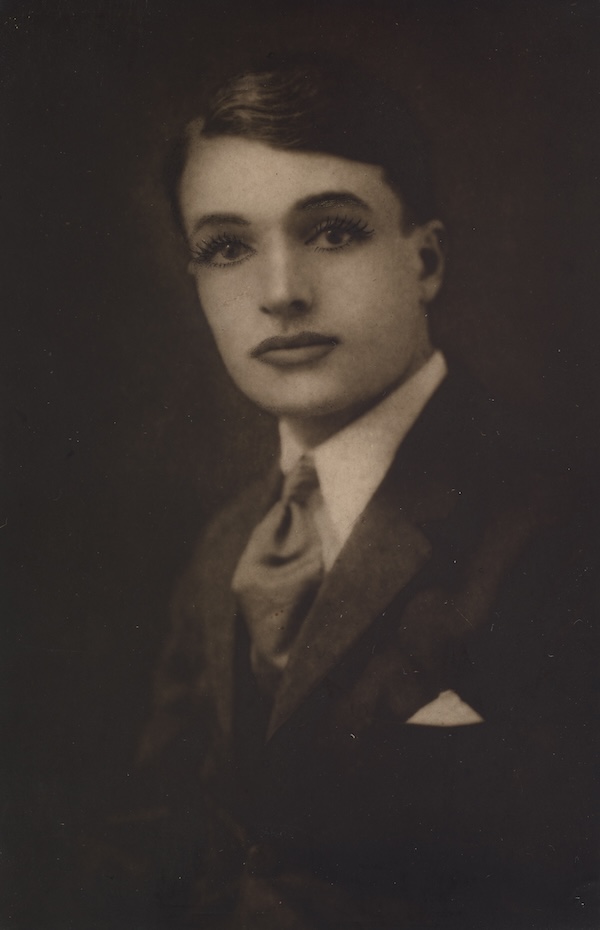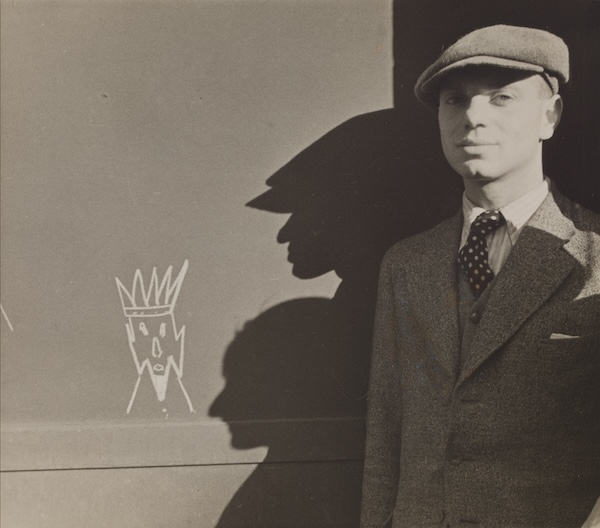'Hello, Stranger': A Conversation with Co-curators Isa Cruz ’27 and Frank Goodyear
By Bowdoin College Museum of Art
Pierre Molinier, Self-Portrait, 1925, printed 1969, vintage gelatin silver print retouched in ink on paper. Bowdoin College Museum of Art, Brunswick, Maine. Gift of David and Gail Mixer. © 2024 Artists Rights Society (ARS), New York / ADAGP, Paris
Co-curated by Isa Cruz ’27 and Frank Goodyear, co-director, Hello Stranger: Artist as Subject in Photographic Portraits since 1900 features thirty-five photographs—self-portraits or portraits of other artists—which reflect radically new propositions for what a portrait might be. They foreground the idea that identity is fluid, bodies are malleable, and strangeness is common. The following conversation with Isa Cruz ’27 and Frank Goodyear, co-director, foregrounds their curatorial process and the conceptual development of the exhibition. The transcript has been condensed and edited for clarity.
Amanda Skinner (AS): What was the original inspiration for the exhibition? How did you settle upon on this topic of “strangeness”?
Isa Cruz (IC): In originally sorting through the list of images in the Mixer Collection gift, we noticed that most of the images represented artists depicting themselves or others. As we continued to view and research the images, what began to emerge thematically was this idea of radical “strangeness” or deviance. Many of the photographs are a refutation of traditional portrait photography and therefore expand upon the format’s capacity to make meaning.
The title of show, “Hello, Stranger,” represents the tension between familiarity and alienation and estrangement from oneself or to another. “Hello” is a common social term but in the context of these photographs, it is made strange. It also alludes to the question of what it means to “queer” something and to make it subtly strange. These are artists reveling in the “strange.”
AS: Along those lines, can you discuss the inspiration for some of the design elements of the exhibition?
IC: In choosing the wall colors and typographic elements, we knew we wanted something fun and to make the queer element obvious. I ended up going down a research rabbit hole as I asked myself questions like “What is queer design?” and even, “Are there gay fonts?” I looked to and drew inspiration from queer designers and archival materials in zine publications from the late twentieth century. We ended up choosing a font for the vinyl called “Lavender Vision,” which comes from the lesbian zine of that name. The lavender walls in the gallery are also a nod to lesbian identity.
These subtle design elements were important to me because the photographs themselves are an important visualization of communities that have experienced so much erasure. Many of the photographers represented fled fascist regimes, and many of the photographs themselves were lost. For example, as two queer, Jewish avant-garde artists, Ellen Auerbach and Grete Stern (pictured below) were forced to flee Germany with the rise of Adolf Hitler and the Nazi Party in the 1930s. For me, the exhibition has a stake in the preservation of these kinds of stories and in resisting the violent fragmentation and denial of these histories.
Frank Goodyear (FG): There are best practices, of course, but no rules when it comes to building an exhibition. This is one of the things that is such a joy about working in a museum. With the decision to organize an exhibition around this extraordinary gift, we had the opportunity to look closely and think creatively at the works in this collection. As we sorted through the photographs, we both gravitated towards some of the “stranger” pictures, and we came to realize that, as Isa said, this was more than just a collection of self-portraits and portraits of artists. These were pictures meditating on what it means to be human and what it means to be grappling with all sorts of powerful forces, many of which are aligned against you. The gift includes 238 photographs, and our challenge was to narrow this collection down to 30 to 40 images that could be accommodated by the gallery space. The photographs ultimately selected for the exhibition are the product of Isa’s thinking about ideas of identity, the body, and queerness.
AS: Are there certain ideas that you hope audiences will take away from the exhibition?
FG: A portrait traditionally considered is a likeness of something visible, and the common consensus is that a “successful” portrait is one that captures that subject faithfully. There’s a role for those types of images in the world but the artists that are represented in Hello, Stranger are proposing new ideas of what a portrait can be and do. These artists were influenced by all sorts of interesting cultural and artistic movements. As a result, they were able to offer radical new propositions of what a compelling portrait might be that exists outside of the margins of tradition.
IC: It’s the exploding open of the genre—portraiture is so expansive and has so many possibilities. The self-portrait especially can play a huge part in this meditation of selfhood. These photographs move beyond the contemporary preoccupation with representing oneself in an idealized way. Photography, and photographic self-portraiture in particular, is a way of asserting oneself and one’s identity in a society that doesn’t always allow us to be our authentic selves.
Hello, Stranger: Artist as Subject in Photographic Portraits since 1900 is on view at the Bowdoin College Museum of Art through March 23, 2024.
Amanda SkinnerAssistant Director of Museum Communications

Grete Stern and Ellen Auerbach (ringl + pit), Walter & Ellen Auerbach, London, ca. 1934, vintage silver print on paper. Bowdoin College Museum of Art, Brunswick, Maine. Gift of David and Gail Mixer. © ringl + pit, courtesy Robert Mann Gallery